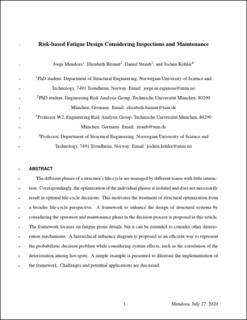| dc.contributor.author | Mendoza Espinosa, Jorge | |
| dc.contributor.author | Kohler, Jochen | |
| dc.contributor.author | Bismut, Elizabeth | |
| dc.contributor.author | Straub, Daniel | |
| dc.date.accessioned | 2020-09-29T14:43:01Z | |
| dc.date.available | 2020-09-29T14:43:01Z | |
| dc.date.created | 2020-09-09T13:52:25Z | |
| dc.date.issued | 2020 | |
| dc.identifier.issn | 2376-7642 | |
| dc.identifier.uri | https://hdl.handle.net/11250/2680374 | |
| dc.description.abstract | The different phases of a structure’s life-cycle are managed by different teams with little interaction. Correspondingly, the optimization of the individual phases is isolated and does not necessarily result in optimal life-cycle decisions. This motivates the treatment of structural optimization from a broader life-cycle perspective. A framework to enhance the design of structural systems by considering the operation and maintenance phase in the decision process is proposed in this article.
The framework focuses on fatigue prone details, but it can be extended to consider other deterioration mechanisms. A hierarchical influence diagram is proposed as an efficient way to represent the probabilistic decision problem while considering system effects, such as the correlation of the deterioration among hot-spots. A simple example is presented to illustrate the implementation of the framework. Challenges and potential applications are discussed. | en_US |
| dc.language.iso | eng | en_US |
| dc.publisher | ASCE-ASME | en_US |
| dc.title | Risk-based Fatigue Design Considering Inspections and Maintenance | en_US |
| dc.type | Peer reviewed | en_US |
| dc.type | Journal article | en_US |
| dc.description.version | acceptedVersion | en_US |
| dc.source.journal | ASCE | en_US |
| dc.identifier.cristin | 1828440 | |
| dc.description.localcode | This material may be downloaded for personal use only. Any other use requires prior permission of the American Society of Civil Engineers. | en_US |
| cristin.ispublished | true | |
| cristin.fulltext | postprint | |
| cristin.qualitycode | 1 | |
